MCE TV Tuner Roundup: Featuring ATI's Theater 550 & NVIDIA's NVTV
by Anand Lal Shimpi on April 12, 2005 6:26 PM EST- Posted in
- GPUs
First Place: ATI TV Wonder Elite
For just about a year now, we've been hearing about ATI's Theater 550 chip, the successor to the highly successful Theater 200 used in the eHome Wonder. The Theater 550 was a bit of a let down in that it seemed a lot like a new release of old technology. What we wanted to see was a hardware MPEG-4 encoder from ATI and what we got instead was the promise of the best hardware MPEG-2 encoder ever. Although it's not the promise we wanted, ATI did deliver exactly what they set out to do.
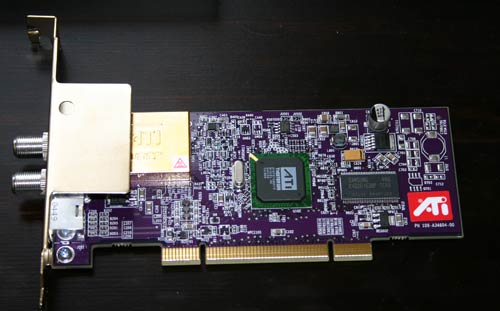
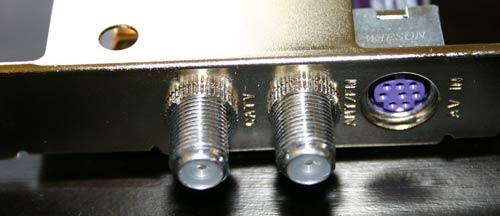
The most noticeable feature of the TV Wonder Elite was that all of the text box issues, which we saw in the competing cards, were gone.

A clean picture and note that there are no issues around the text boxes.

You can't get totally sharp text off of a SD signal, but you get text that's very legible and artifact-free with the TV Wonder Elite.
Upon closer investigation, the image quality of the TV Wonder Elite is better in many little ways compared to the competition here. The color reproduction is much more true. There are much lower levels of noise and you can even see detail in actors on the screen. Compared to the second place Hauppauge card, the differences are much more subtle, but in back-to-back comparisons, you do notice differences between the two cards. The Hauppauge does appear to have higher levels of color saturation, but the TV Wonder Elite seems to produce a more "correct" image.
ATI TV Wonder Elite
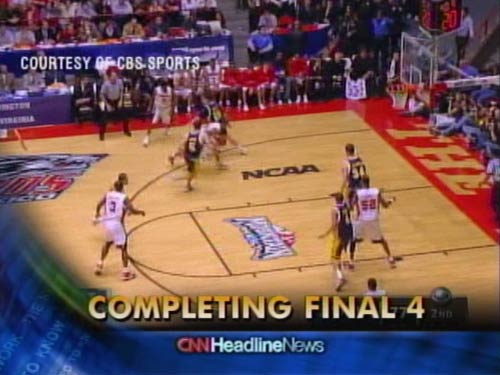
Hauppauge WinTV PVR-250
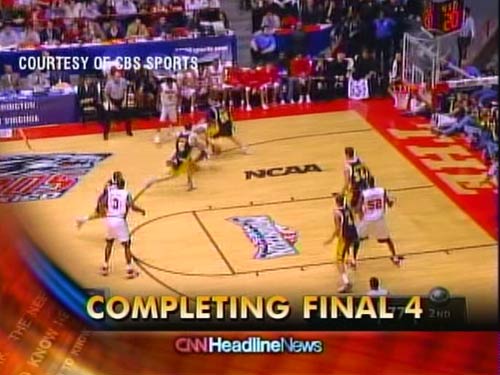
Ignoring the differences in border colors (the video feed in the center is still the same), the TV Wonder Elite offers more accurate color reproduction.
As slight as those differences may be, given the price parity between the Hauppauge and the TV Wonder Elite, we give the nod to ATI here.
What the TV Wonder Elite doesn't do, however, is the type of improvement in image quality that ATI's marketing material would have you believe; the biggest reason being that SD cable signals are simply not good enough for those types of improvements to be seen. The TV Wonder Elite isn't perfect, while it is still susceptible to the quality of your cable feed, but out of the competitors here, it's as good as it gets.
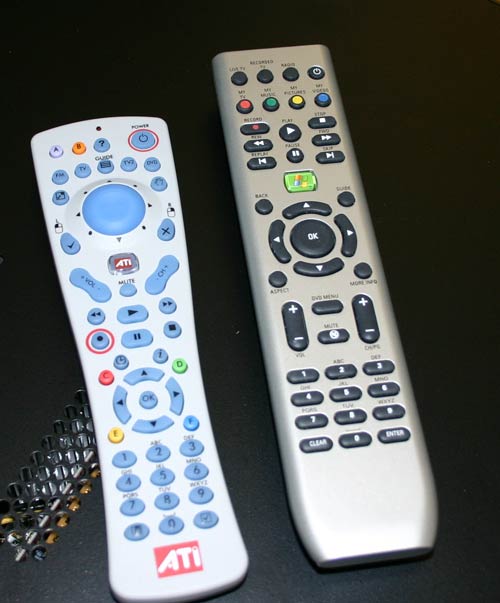
ATI's Remote Wonder Plus (left) vs. a standard MCE remote (right)
The retail TV Wonder Elite ships with ATI's new Remote Wonder Plus, a much improved remote control design over previous ATI remotes. Unfortunately, the Remote Wonder Plus will not function as a MCE remote. You'll still have to shell out the $30 for one of those if you're building a MCE machine.
Although we have specifically decided not to focus on software bundles (given that the premise of this roundup is finding a TV tuner card for a MCE system), ATI does ship the TV Wonder Elite with a copy of CyberLink's PowerCinema with an ATI skin. At first glance, the ATI Edition of PowerCinema looks a lot like a red version of the MCE interface. However, as soon as you start to use it, you realize its shortcomings. The interface is extremely slow to respond compared to MCE and it still features no integrated program guide, which renders it useless as a serious PVR tool by today's standards. As a standalone TV tuner, the TV Wonder Elite's bundle leaves much to be desired, but as a companion to Windows XP Media Center Edition, ATI has released the best quality tuner on the market from what we've seen.
The biggest drawback of ATI's TV Wonder Elite is its price point - between $140 and $160, the TV Wonder Elite is ridiculously expensive for a SD TV tuner. But if you want the best, it's your only option.










61 Comments
View All Comments
shplad - Sunday, May 1, 2005 - link
Hey legalbob2:So my theory was right. We all have a bit of "closet geek" in us somewhere, it just takes the right stimuli to bring it out. Didn't know you were perusing these boards these days. What video equipment are you using?
Watch out for that nasty broadcast flag. Unless Blockhead's brother can help you figure out a way around it. Me, I'm buying my TV tuner cards (to go into my MythTV machine) now before there are any legal issues.
You should watch out where you post, you never know what kind of crazies your post might attract ;-)
Madman
wuhoo - Monday, April 18, 2005 - link
any laptop tv tuner card reviews? with winodws media center, one could have a mobile dvr w/ laptopsgotsmack - Friday, April 15, 2005 - link
maybe add in Pinnacle cards for the next review?goinginstyle - Friday, April 21, 2006 - link
When is the next review?Sidescraper - Thursday, April 14, 2005 - link
The Haupauge card pictured is nothing like the card I have. Haupauge MCE cards have an FM tuner. The non-MCE cards have an IR remote. The 350 has a MPEG decoder in hardware. See here:http://htpcnews.com/main.php?id=pvr_card_id_guide
Kishkumen - Thursday, April 14, 2005 - link
#55 - That's correct. If the channels you care about require a cable box and cannot be seen using just your regular TV, then these analog tuners won't do you much good. I have heard of people being able to connect a serial cable to their cable box and use scripts to get their PVR software to change the channel on their cable box or satellite receiver, but that gets complicated.cer1 - Thursday, April 14, 2005 - link
#49 and #53Thanks for the info. In my case I'd be looking for to build a PVR to go with my Comcast Digital Cable signal. If I need to use the cable box to set the channels, then, as I understand it, using one of these cards would not be so useful to me. That is, the purpose is defeated if I can not program the PVR to record specific channels at specific times.
In this review are the cards getting signal from a cable box or are they being used with an analog signal?
lapierrem - Wednesday, April 13, 2005 - link
Not sure where you got the 350 being equivalent to the 250. The 350 has a hardware MPEG-2 De-coder, which may be redundant on faster systems, but would be a difference on a lower end MCE system, and the 250/150 don't have it. It's the 150/250 that are pretty much equivalent. Good review though.Kishkumen - Wednesday, April 13, 2005 - link
#48 - I am by no means an expert, but here is what I know about video sources in relation to the cards reviewed here. The cards reviewed here are only analog cards. They cannot take take a digital signal due to the tuners used. They can be used with digital cable, but the term as traditionally used is kind of a misnomer. Typically your cable company will have a basic package that includes a range of unencrypted, analog channels. You will only be able to use the onboard tuners of the various capture cards with these unencrypted, analog channels. After this, a cable company will often have what they term a "digital" package of a range of higher cost premium channels. The "digital" term tends to be kind of confusing. Typically these "digital" channels are taken from analog sources, digitally encrypted and then sent to a cable box which then decryptes the "digital" channel back into analog. The cards reviewed here will can then take that decrypted analog signal and convert it back into digital, but you will not be able to change channels with the capture card itself. You will have to use your cable box for that.After this, you have HDTV which is finally a true digital signal in the form of a transport stream. HDTV can be delivered either in high definition if the video is 720p or standard definition if the video is 480p or below. In reality, the transport stream is nothing more than a very high bitrate mpeg2 video. The capture cards reviewed here will not work with such a digital signal because they only have analog tuners.
In addition to over the air HDTV, cable companies are starting to come out with HDTV cable. They use an encryption scheme called QAM which differs from the transport stream signal delivered over the air. The QAM signal may or may not be encrypted depending on your cable company. If encrypted you will again be required to rent or purchase a cable box to decrypt the signal.
Anyway, I hope that clarifies things for you as far as source material goes for these cards.
Crucial - Wednesday, April 13, 2005 - link
I might have missed it but did the review state what mpeg2 decoder was being used? This makes a big difference in the quality and should have also been tested. I personaly find the PowerDVD decoder to be the best.Major disappointment to not see the PVR-150. I have 2 of them in my HTPC along with an HDTV Wonder. I switched to the pvr-150 from ehome wonders after Windows MCE kept losing the ehome wonders requiring a reboot.
Also why was there a mini review of the Winbook stuff thrown in? It was like a way to generate some ad revenue. I would have rather seen another page describing the difference between the mpeg decoders.
Overall this article stunk.